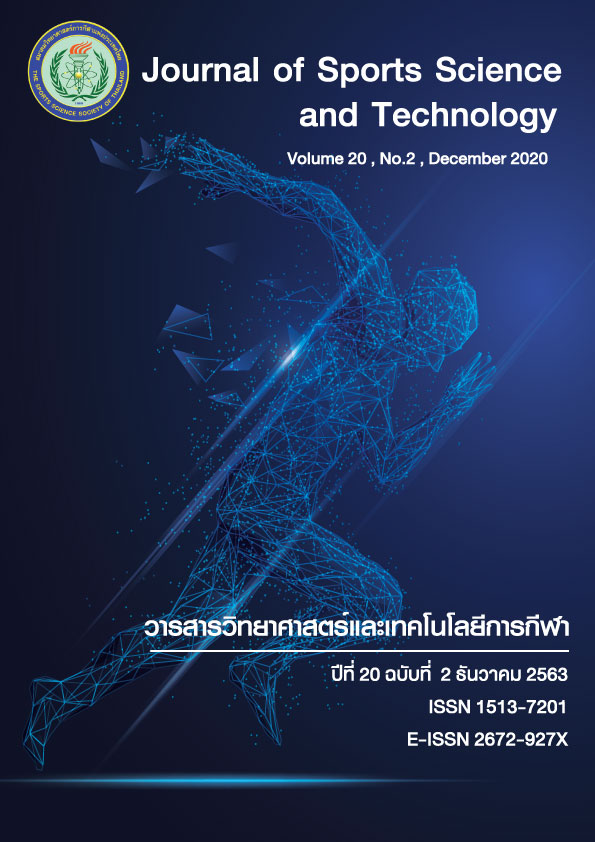COMPARISON OF THE EFFECTS OF ANAEROBIC ENDURANCE TRAINING PROGRAM ON PERFORMANCE OF ENERGY AND MUSCULAR SYSTEM DEVELOPMENT IN TRADITIONAL LONG BOAT OARSMEN
Keywords:
Anaerobic endurance training/, Performance, Traditional long boat oarsmenAbstract
The purpose of this study was to compare the results of anaerobic endurance training program using
different ratio of training time and rest time on performance of energy and muscular system development in
traditional long boat oarsmen. Thirty subjects were traditional long boat oarsmen aged 15-18 who participated in the traditional long boat race in Samut Sakhon province. The subjects were randomized into different anaerobic endurance training program which were the experimental group 1 using the ratio of training time and rest time 1:2, the experimental group 2 using the ratio of training time and rest time 1:3, and the experimental group 3 using the ratio of training time and rest time 1:4 for 8 weeks. Data anaerobic capacity, anaerobic power,aerobic capacity, hand strength, leg muscles strength, abdominal muscle endurance were analysed and reported as Mean, Standard diviation, t-test, and F-test.
The result of the research found that the experiment of group 1 had greater mean of aerobic capacity
after the experiment than before the experiment statistically significant at a level of 0.05; The experiment of
group 2 had greater mean of aerobic capacity and leg muscle strength after the experiment than before the
experiment statistically significant at a level of 0.05; The experiment of group 3 had greater mean of aerobic
capacity and leg muscle strength after the experiment than before the experiment statistically significant at a
level of 0.05. All of experimental group had greater mean of leg muscle strength and abdominal muscle
endurance after the experiment than before the experiment statistically significant at a level of 0.05. Therefore comparing the differences of the mean individually using Bonferroni’s test method. It was found that the experiment of group 3 had greater mean of leg muscle strength than the experiment of group 1 statistically significant at a level of 0.05.
Summary of the research of anaerobic endurance training program with 1:2, 1:3, and 1:4 ratio of
training time and rest can improve aerobic capacity, leg muscle strength, and abdominal muscle endurance.
(Journal of Sports Science and Technology 2020; 20(2):81-95)
(Received: 21June 2020, Revised: 10 November 2020, Accepted: 16 November 2020)
KEY WORDS: Anaerobic endurance training/ Performance/ Traditional long boat oarsmen
*Corresponding author: Wipoj CHANSEM
Faculty of Sports and Healyh Science,
Thailand National Sport University, Samutsakhon Campus
E-mail: drwipoj@gmail.com
References
2 Nolte V. Rowing faster. Human Kinetics 1; 2005.
3 Ratamess NA. Adaptations to anaerobic training programs. Essentials of strength training and conditioning. 2008;3:94-119.
4 Cohen, J. Statistical Power Analysis for the Behavioral Sciences. Revised Edition. Academic Press.;2013
5 Samahito S. Physical fitness test for seniors aged 60 - 89 years. Bureau of Sports Science: Department of Physical Education, Ministry of Tourism and Sports; 2013
6 Seo, MW, Lee, JM, Jung, HC, Jung, SW, Song, JK. Effects of Various Work-to-rest Ratios during High-intensity Interval Training on Athletic Performance in Adolescents. Int J Sports Med. 2019 Aug;40(8) : 503-510.
7 The Gains Lab. Interval Training Overview [internet]. New Orleans (NO): The gains lab; 2020 [cited 2020 jan 15]. Available from: https://www.thegainslab.com/interval-training
8 Sporis G, Ruzic L, Leko G. The anaerobic endurance of elite soccer players improved after a high-intensity training intervention in the 8-week conditioning program. J Strength Cond Res. 2008 Mar 1;22(2):559-66
9 Sonthichan V and Muangmee P. The effect of interactive training at different levels of intensity and duration to the maximum ability to oxygen consumption, Hemoglobin content anaerobic performance and anaerobics treashold. PHJBUU. 2013 Jan – Jun; 8 (1) : 68-79.
10 Lamminen R. Anaerobic Training, Sprint to Success. [internet]. Jyvaskyla: Firstbeat Technologies Oy; 2020 [cited 2020 jan 20]. Available from: https://www.firstbeat.com/en/blog/anaerobic-training-sprint-to-success
11 Ricketts D. Anaerobic Exercise: Definition, Benefits & Examples. [internet]. Mountain View (MV): Study.com; 2020 [cited 2020 fab 5]. Available from: https: //study.com/academy/lesson/anaerobic-exercise-definition-benefits-examples.html)
12 Weeraphan Phrompinij, Ratree Ruangthai and Niromlee Makaje. Effect of High Intensity
Interval Training in Deep Water and Treadmill on Maximum Oxygen Consumption in
Team Athlete. Journal of Sports Science and Technology. 2019; 19 (2) : 8 – 19.
13 Worasit Seaburin, Warayot Laha and Ashira Hiruntrakul. The Effect of Continuous Exercise and
Interval Exercise on Aerobic and Anaerobic Fitness of Student. Journal of Sports Science and
Technology. 2015; 15 (2) : 33 – 41.






